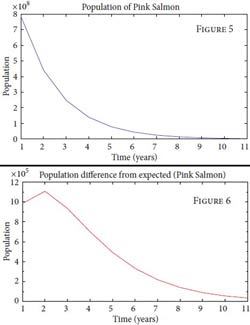http://www.asyura2.com/15/genpatu43/msg/259.html
| Tweet |
Study: Fukushima radiation will cause long-term harm to Pacific salmon population — Efforts needed to protect species from possible extinction — Radiation monitoring is critical to avoid human health problems — “US inland areas also at risk of exposure”
研究:福島の放射能は、太平洋鮭(さけ)の個体群に対し長期的な害の原因になります -絶滅の可能性から種を守る取り組みが必要である - 放射能モニタリングは人間の健康上の問題を回避するために重大です - 「米国内陸部も曝露の危険性があります」
Published: June 16th, 2015 at 5:03 pm ET By ENENews
公開:2015年6月16日午後5:03 ET ENENewsによる
Journal of Applied Mathematics — Modelling the Effects of Radioactive Effluent on Thunnus orientalis and Oncorhynchus gorbuscha, New Jersey City Univ. (Chen, Ding, Laracuenti, Lipat (Columbia Univ., NASA Goddard Institute for Space Studies)), 2013 (emphasis added):
応用数学ジャーナル – クロマグロとカラフト鱒(ます) に対する放射性廃液の影響をモデル化、ニュージャージー市立大。(チェン、ディン、ララキュエンティ、リパット(コロンビア大学、宇宙研究のためのNASAゴダード研究所))、2013年(強調は記者):
The contamination of the Pacific Ocean by the radioactive pollutants released from the Fukushima Daiichi Nuclear Power Plant has raised legitimate concerns over the viability of marine wildlife. We… explore the extent of the effects of the radioactive effluent on two marine species: the Pacific Bluefin Tuna and the Pacific Pink Salmon…
福島第一原子力発電所から放出された放射性汚染物質による太平洋の汚染は、海洋生物の生存能力に関して正当な(間違いない)懸念を起こしています。我々は... 2つの海洋生物種の放射性廃液の影響の程度を探ります:太平洋クロマグロと太平洋ピンクサーモン...
Because of the brevity of the period of time during which radioactive material was discharged… [it's] assumed to be instantaneous [note the study was released before TEPCO admitted the flow of radioactive material into the Pacific never ended]…
放射性物質が放出された時間・期間を簡略化するために... [それ(放射性物質の放出)は]瞬間的であると仮定されています、[その研究は、東京電力が太平洋への放射性物質の流れは決して終わらない事を認める以前に、リリース(発表)されたことに注意してください]...
This pollution was spread through the entire Pacific Ocean…
この汚染は太平洋全体に広がりました...
A numerical solution… will simulate the effects of the Fukushima Daiichi nuclear disaster… This simulation has far-reaching implications for decisions related to the location of nuclear power plants as well as to fishing policy…
数値解析は...福島第一原子力発電所事故の影響をシミュレートします...このシミュレーションは、原子力発電所の位置付けに関連する決定に対し、遠大な意味を持っています、漁業政策に関する決定も同様です...
According to data released by Tepco, the initial concentrations of radioactivity following the release of 11,500 metric tonnes of contaminated water into the Pacific Ocean… are 310,000 Bq/L of iodine-131, 230,000 Bq/L of caesium-134, and 230,000 Bq/L of caesium-137 [which] produces the initial radioactivity of the iodine-131: 3.57 trillion Bq… caesium-134: 2.65 trillion Bq… caesium-137: 2.65 trillion Bq [note that estimates by gov't scientists are 10,000+ times higher]…
東電が発表したデータによると、太平洋への汚染水11,500トンの放出後に、放射能の初期濃度は...ヨウ素131が31万ベクレル/ L、セシウム134が23万ベクレル/ L、そしてセシウム137が23万ベクレル/ Lです
[それ(に対する我々の発表したデータ)は]ヨウ素131:3兆5700万ベクレル...セシウム134:2兆6500万ベクレル...セシウム137:2兆6500万ベクレルの初期放射能を産生しています[(米国) 政府の科学者による推定は1万倍高いことに注意してください]...
Analysis of the results shows that the Pacific Bluefin Tuna will experience a steeper population decline in the short term compared to its expected population decline… after which the population will return to the expected population.
結果の分析は、太平洋クロマグロはその予測された個体群減少と比較して、短期的には急峻な個体群減少を経験することを示しています...その後、個体群は予測された個体群に戻ります。

Pacific Pink Salmon, on the other hand, will simply decline at a faster pace than the expected population decline… radioactive effluent will result in a marked and lasting decrease in population [see Fig. 5, 6]…
太平洋ピンクサーモンは、これに反して、単純に予想される個体群減少よりも速いペースで低下するでしょう...放射性廃液は、著しく、持続的な個体群減少をもたらすであろう[図5、6を参照してください。] ...
Before the conclusions are subjected to social analysis, the model’s limitations must be considered… the model does not reflect the migratory nature of both fish species. This does not, however, entirely negate the validity of the simulation: over a sufficiently long period of time, the short-term movement of the fish throughout the Pacific Ocean becomes negligible… The results of the model… opt to consider the fish species’ population on average…
結論が社会的な分析を受ける前に、モデルの限界を考慮しなければなりません...モデルは、両方の魚種の回遊性を反映していません。これは、しかしながら、シミュレーションの妥当性を全く否定するものではありません:十分長い時間にわたって、太平洋全体での魚の短期的動きは無視できるようになります...モデルの結果は...平均した魚種の個体群を考慮することを選びます...
The very high rate of decline of the Pacific Pink Salmon indicates that live specimens may contain relatively high levels of radioactivity. Continued monitoring of the Pacific Pink Salmon, as well as all marine species, for radioactivity will be critical to the avoidance of health problems for humans. Because the species migrates throughout freshwater rivers and tributaries of British Columbia, Alaska, and the Pacific Northwest of the United States, inland areas are also at risk of exposure to, at the very least, low-level radioactivity. Moreover, the rapid rate of decline of the Pacific Pink Salmon, in conjunction with rapidly deteriorating conditions, seems to necessitate drastic action. Work beyond sustainability is needed to protect the species from possible extinction…
太平洋ピンクサーモンの衰退率が非常に高いことは、生の試料が放射能の比較的高いレベルを含有していることを示しています。放射能に対する太平洋ピンクサーモンの継続的監視は、全ての海洋生物種のそれも同様に、人間にとって健康上の問題を回避するために重大となります。その種(ピンクサーモン)は、(カナダ)ブリティッシュコロンビア州、アラスカ、米国の太平洋岸北西部の淡水の川や支流全体に移住しているため、内陸部も、少なくとも、低レベル放射能への曝露リスクがあります。また、太平洋ピンクサーモンの衰退の急速な速度は、急速に悪化した条件に関連して、抜本的な行動が必要とされると思われます。持続性を超えた任務が絶滅の可能性から種を保護するために必要です...
Because of the deleterious effects on the marine environment… it seems reasonable to suggest that any new nuclear power plants be constructed sufficiently far from coastal waterways so as to mitigate the absorption of any radioactive contaminants into the biosphere. This, however, would pose a risk to the environment near the nuclear power plant without the capacity of an ocean to diffuse the radioactivity…
海洋環境への有害な影響のために... 生物圏への如何なる放射性汚染物質の吸収を緩和するために、新規の原子力発電所は沿岸水路から十分に離れて構築することを示唆するのが妥当と思われます。このことは、しかしながら、放射能を拡散させる海の受容能力なしでは、原子力発電所の近くの環境にリスクをもたらすでだろう...
The authors are thankful to [National Science Foundation award] NSF HRD-0902132 (LSAMP) for the support to do this research.
著者らは、[国立科学財団賞] 全米科学財団NSF HRD-0902132(LSAMP)へ、この研究を行うことへのサポートに対し感謝しています。
See also: Scientists: Radioactivity in food web off Pacific Northwest to “significantly increase” — Salmon forecast to exceed Japan radiation limit — “Major concern for public health” (POSTER)
参照:科学者:「大幅に増加」する太平洋北西部沖の食物(連鎖)網中の放射能 – 鮭(さけ)は日本の放射能の限界値を超えることが予測されます - 」公衆衛生にとって多大な懸念」(ポスター発表)...
|
|
|
|
投稿コメント全ログ コメント即時配信 スレ建て依頼 削除コメント確認方法
▲上へ ★阿修羅♪ > 原発・フッ素43掲示板 次へ 前へ
|
|
 スパムメールの中から見つけ出すためにメールのタイトルには必ず「阿修羅さんへ」と記述してください。
スパムメールの中から見つけ出すためにメールのタイトルには必ず「阿修羅さんへ」と記述してください。すべてのページの引用、転載、リンクを許可します。確認メールは不要です。引用元リンクを表示してください。